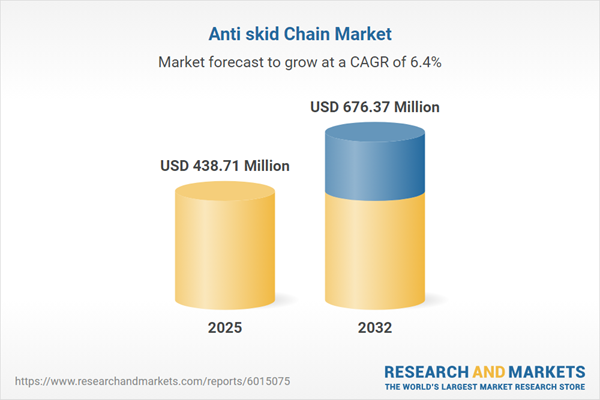Speak directly to the analyst to clarify any post sales queries you may have.
As regulatory demands and supply chain challenges reshape industrial priorities, organizations in transportation and logistics require reliable strategies to maintain operational resilience and manage evolving risks. The anti skid chain market is advancing in response, offering critical tools and insights for stakeholders overseeing investment and procurement decisions in dynamic sector conditions.
Market Snapshot: Anti Skid Chain Market
The anti skid chain market expanded from USD 412.34 million in 2024 to USD 438.71 million in 2025 and is forecast to reach USD 676.37 million by 2032, reflecting a CAGR of 6.38%.
Market momentum is sustained by evolving vehicle and workplace safety mandates, manufacturing advancements, and integration of sustainable innovations. Adoption rates are strong across both passenger and commercial vehicles, empowering organizations to refine operational models. The availability of digital monitoring tools and advanced analytics is improving decision-making, enabling operators to optimize performance and manage risk effectively across global markets.Scope & Segmentation: Anti Skid Chain Market
This report delivers comprehensive intelligence designed for executive needs, supporting strategic development, competitive analysis, and risk management in the anti skid chain sector. Covered segments include:
- Distribution Channels: Insights into organized aftermarket, unorganized supply chains, and OEM partnerships reveal pathways to resilience and accessible supply options for buyers at all operational scales.
- End Use: The analysis addresses traction and safety requirements for automotive fleets, industrial vehicles, and rail systems operating within logistics, heavy-duty transport, and emerging urban mobility sectors.
- Material Types: Assessment includes alloy steel, carbon steel, and stainless steel, enabling stakeholders to align choices with organizational priorities for durability, cost efficiency, and sustainability targets.
- Product Types: Comparison of diamond, ladder, and ring pattern chains outlines dependability and suitability across different transport and industrial settings.
- Applications: Coverage spans usage in commercial fleets, agricultural and mining machinery, construction, forestry equipment, and key passenger transport, addressing broad spectrum risks and regulatory requirements.
- Regional Coverage: The report analyzes market dynamics in North America, South America, Europe, Middle East & Africa, and Asia-Pacific, helping buyers tailor procurement strategies in diverse regulatory and operating environments.
- Technology Adoption: Examination of laser-based pattern development, computer-aided product design, digital monitoring platforms, and composite processing technologies identifies levers for cycle improvement and operational gains.
- Leading Companies: Profiles include Pewag Austria GmbH, König GmbH, Thule Sweden AB, Rud Chain Inc., TK Chain Co., Ltd., AutoSock AS, Yoyik Corporation, Kose Inc., Security Chain Company LLC, and Yukon Equipment Inc.
Key Takeaways for Decision-Makers
- Anti skid chains remain a cornerstone for ensuring regulatory compliance and stabilizing operations where climate variability and rigorous safety standards persist.
- Progress in engineering and design extends product lifespan, making solutions suitable for a broader range of vehicle categories exposed to harsh usage conditions.
- Procurement approaches are shifting toward supplier diversity and sustainability, aligning long-term competitiveness for logistics providers and industrial end-users.
- Flexible access to distribution networks, including OEM and aftermarket channels, supports stability and responsiveness within uncertain supply scenarios.
- Customization based on regulatory nuance and risk assessment enhances organizational readiness, ensuring optimal fit across operational footprints.
- Ongoing collaboration with manufacturers and technology partners supports adaptation to shifting standards and evolving quality benchmarks.
Tariff Impact: Navigating U.S. Import Barriers
Recent U.S. tariff policy updates have increased import complexity, prompting manufacturers to reassess sourcing models and consider nearshoring to mitigate risk. Distributors and fleet operators are emphasizing strategic contracting and inventory controls, highlighting the value of supplier diversification and material innovation to support resilience amid potential disruptions.
Methodology & Data Sources
Findings in this report stem from executive-level interviews, direct factory evaluations, and corroborated third-party market research. Data credibility is strengthened through laboratory performance testing, field trials, and compliance audits led by recognized subject matter experts.
Why This Report Matters: Anti Skid Chain Market
- Gives executive, procurement, and operational leaders tools to improve sourcing, investment, and partnership strategies within the anti skid chain market.
- Establishes a strategic framework for addressing regulatory change, sound risk management, and sustainability imperatives across multiple sectors and regions.
- Delivers a timely perspective on technology advancement and supply network developments critical for resilient decision-making.
Conclusion
This report consolidates critical insights and developments in the anti skid chain market, enabling senior leaders to enact strategies that ensure sustainable resilience and competitive positioning in a changing global landscape.
Additional Product Information:
- Purchase of this report includes 1 year online access with quarterly updates.
- This report can be updated on request. Please contact our Customer Experience team using the Ask a Question widget on our website.
Table of Contents
3. Executive Summary
4. Market Overview
7. Cumulative Impact of Artificial Intelligence 2025
Companies Mentioned
The companies profiled in this Anti skid Chain market report include:- Pewag Austria GmbH
- König GmbH
- Thule Sweden AB
- Rud Chain Inc.
- TK Chain Co., Ltd.
- AutoSock AS
- Yoyik Corporation
- Kose Inc.
- Security Chain Company LLC
- Yukon Equipment Inc.
Table Information
| Report Attribute | Details |
|---|---|
| No. of Pages | 184 |
| Published | October 2025 |
| Forecast Period | 2025 - 2032 |
| Estimated Market Value ( USD | $ 438.71 Million |
| Forecasted Market Value ( USD | $ 676.37 Million |
| Compound Annual Growth Rate | 6.3% |
| Regions Covered | Global |
| No. of Companies Mentioned | 11 |









